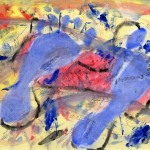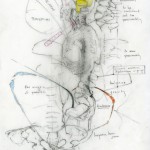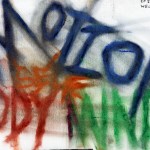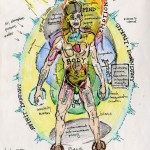Somatics is an embodied philosophical approach to living; therefore, practice is an essential part somatic discovery. Somatic education requires more than cognitive understanding of its theoretical philosophy because for each mover this understanding is established from a unique personal experience. Only by doing can each individual truly understand what it is for him or her to be of a somatic existence. The following are practices of awareness you can embody to enliven somatic concepts on your own, with a partner, as a community, in class, or as part of a workshop to tap into your inner self in relation to others. As movers, we understand all practices to be in-body, but all practices also include emotional, spiritual, and mental elements. We are, after all, bodywhole.
1. Mindful Moving
Mindful Moving is a somatic practice used by Professor Sheryl Saterstrom at St. Olaf College in Northfield, Minnesota. It is approximately a half-hour practice consisting of ten minutes of moving, ten minutes of balancing/aligning, and ten minutes of focusing on breath. The three components may be heavily or slightly directed or purely open to exploration. Mindful Moving evolved from a practice called Moving Meditation, which shares the same 10-10-10 structure. In Moving Meditation, however, the three sections are more heavily guided by a designated leader who gives specific directives. The following is a sample of Mindful Moving.
Moving: Open attention — as you move, notice what you sense, experience, realize, feel, think, etc. Pick something that interests you and continue to explore.
Balancing/Aligning: Align the three major weight centers — skull, shoulder girdle and rib cage, pelvic girdle; Balance all of your body halves — upper/lower, right/left, front/back, inner/outer, core/periphery, etc.
Breathing: Add breath to what you are already doing; lie in Constructive Rest, focusing on your inhale and exhale, breath rhythms, shape and function of the lungs, etc.
The following is an example a directed structure for the first parts of Mindful Moving.
2. Ball Play
Ball Play allows the mover to experience his or her own weight and momentum in a new way. Unlike the way the mover normally experiences body weight, the mover’s weight is more or less entirely entrusted to this bubble of air beneath them. The round surface of the ball enhances the mover’s momentum and alters his or her sense of stability from the ground. This requires the mover to provide control over his or her own momentum through high awareness and internal understanding of the body in space. Additionally the ball allows the mover to experience the curved, three dimensional nature of the body sinking into yet also supported by the ball’s surface.
3. Mapping the Somatic Self
We experience our bodies in many different ways through many different mediums. How we visualize, conceive of, and inhabit our bodies is influenced by nature, painting and sculpture, music, poetry, food, spiritual practices, family values, etc. Somatic maps offer new ways to think about how we be and do.
- A few of the feet and pelvis from the bottom up
- If I look like a mess, well then I must be a mess
These examples of body-maps are student projects from several years of a beginning modern course taught at St. Olaf College by Sheryl Saterstrom.
4. PostureScreen Mobile
Somatic founder Ida Rolf was deeply concerned with correcting vertical alignment of the body for more efficient movement. She viewed the body as distinct, manipulatable architectural blocks that, in the right alignment, cooperate fluidly and flexibly for easeful movement. Moving into the technology of the 21st century, we recently found this App for Mac products as a fun tool for assessing postural alignment. Among the many useful functions of this app, it lays a grid over the picture of a person and allows the user to draw connections between areas of the body that should be in alignment to easily observe patterns of misalignment that could yield unnecessary tension in the body. This also can be easily achieved in a classroom by having students stand in front of a grid. Please check out PostureAnalysis.com for more information!
If you have a movement awareness practice to offer please email us at simplysomatic@gmail.com!






